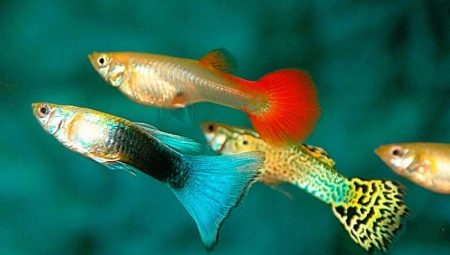Guppies are bright unpretentious fish. They can be easily bred at home, this can be done both in the general aquarium and in a separate spawning ground. Viviparous fish, fry are born fully formed. It is easy to grow young animals, even a novice aquarist can cope with them.
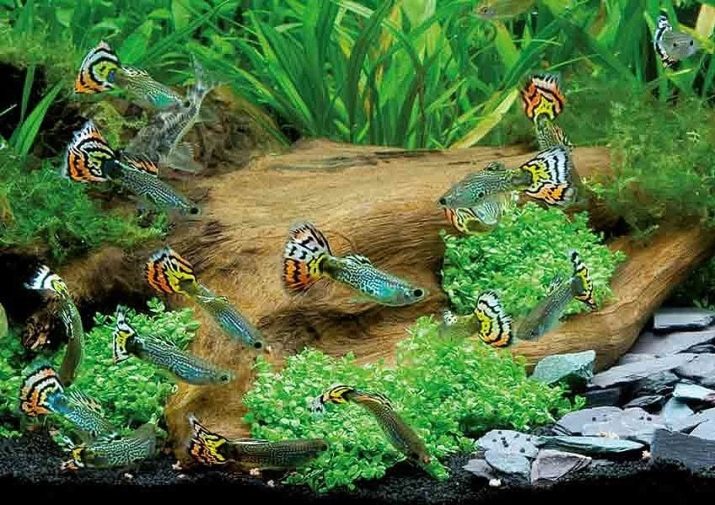
How to distinguish a female from a male?
Guppies are characterized by sexual dimorphism. It is easy to determine the sex of the fish, this can be done by focusing on 5 signs.
- Color. Males are much more colorful, their body and tail shimmer with all kinds of colors. Females look more modest, the abdomen is weakly colored, and some species are completely colorless.
- Body size. Females are larger and more pot-bellied. The body of the males is more elongated and slender.
- Tail. Males have chic tails: long, flowing, with an unusual pattern or patterns. The tail of the female is small, often rounded and slightly colored. It may contain only a couple of colored specks or not at all.
- Dorsal. When the male is swimming, his dorsal fin flutters beautifully, it is long and brightly colored. The female is rounded, pale or with a light pattern.
- Anal fin. The male in the anal fin region has gonopodia - the sexual organ of fish. It has an elongated narrow shape. Females do not have it, but a dark spot can be found in the lower abdomen.
As is clear from the description of the differences, males look much more spectacular in the aquarium. But breeders recommend keeping an equal number of males and females in the same pond.
If in the aquarium there are too many males per female, they can drive her to exhaustion, from which she sometimes dies.
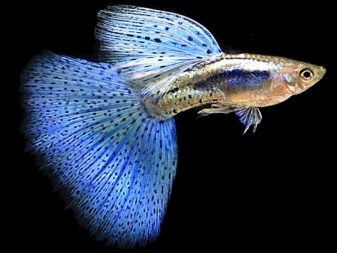
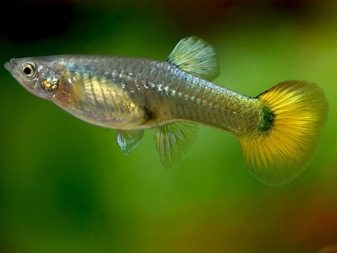
What is the best way to breed fish?
Guppy breeding is possible in a common aquarium without human intervention. They are very prolific and breed well on their own. If this does not happen, then the following reasons are possible:
- same-sex flock;
- too cold water (less than + 22 ° C);
- overpopulated aquarium (less than 1 liter of water per one fish);
- severe pollution of the aquatic environment.
Another reason is the carelessness of the owner. There are times when guppies successfully spawn, but large fish eat fry. This occurs when there is no shelter in the aquarium. Therefore, for the survival of offspring, the "water world" is planted with thick algae, and grottoes with narrow indentations are chosen as the decor.
And even such arrangement of the aquarium does not guarantee the safety of the kids, therefore, when fry are detected, they should be deposited in a separate container. The same thing is done with a pregnant female, if the fish has a rounded stomach, and a dark spot has formed in the area of the anal passage, a separate reservoir is provided before the birth itself.
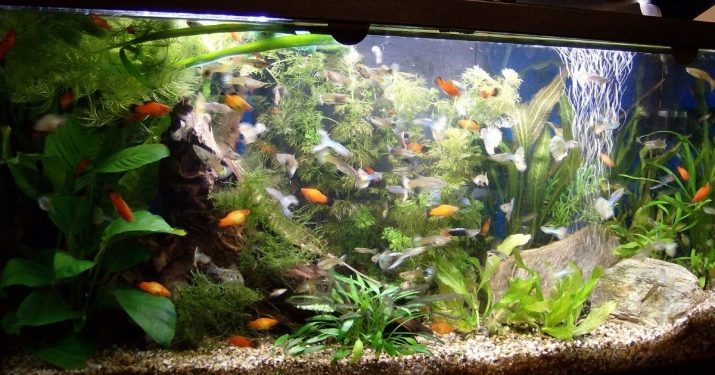
There are many varieties of guppies; among themselves they differ mainly in the color and shape of the fins. These aquarium fish are striking in their variety of colors: blue, red, green, yellow, orange, black and leopard. Most often, with random and random reproduction of guppies, individuals with the most beautiful and rare colors degenerate. Therefore, to maintain the purity of the species or during breeding work, males and females are kept separately. And in the equipped spawning grounds, the best representatives of the species are interbred.
Breeding is an interesting activity that even beginner breeders can handle. Guppies of different species can be crossed with each other and new breeds with a unique combination of colors can be bred. In Russia, breeders annually hold fish contests with the brightest and most original colors.
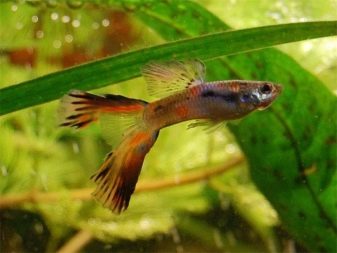
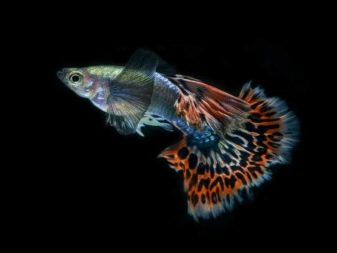
Selection of individuals
In order for the fry to be healthy and beautiful, they responsibly approach the choice of “parents”, Paying attention to the following features:
- body proportionality;
- flat back without a hump;
- long fins;
- powerful base of the tail;
- bright color without defects;
- active behavior;
- age from 4 months.
It is necessary to choose only those individuals in which the last spawning was at least 2 months ago.
To obtain breeding fry, the best male and female of the same species are selected, and for experiments with color, fish of different species are selected. Before you put the pair to spawn, they are fed with live food: bloodworms, tubule mumps or corvette.
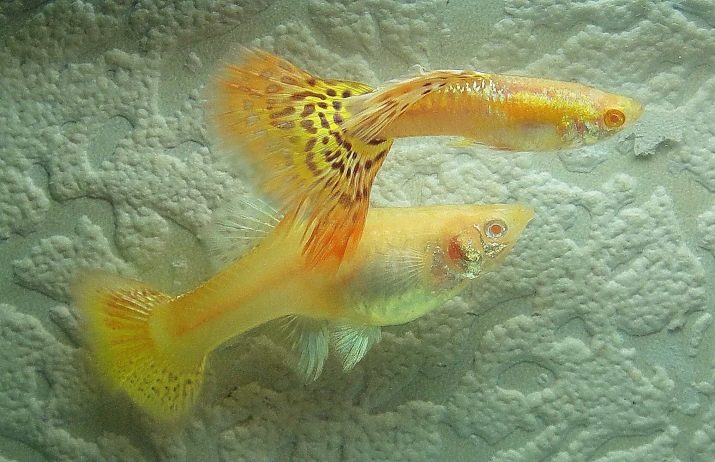
Arresting spawning
Guppies are unpretentious, so you can breed them even in a 3-liter jar. But they will be more comfortable in a small aquarium, equipped in accordance with the following recommendations:
- 70% of the water should be taken from the general aquarium, which contained fish, and 30% - clean, decanted water;
- water aeration and additional lighting are desirable;
- to stimulate spawning, the water temperature is gradually raised to + 29 ° C.
The most important indicator to monitor is the temperature of the water. Guppies are thermophilic, so if the spawning is cool, you must use a heater. It is placed inside the tank and allows you to heat the water to the desired value. The male and then the female are first launched into the prepared spawning ground. This is necessary in order to reduce the dominant behavior of the female.
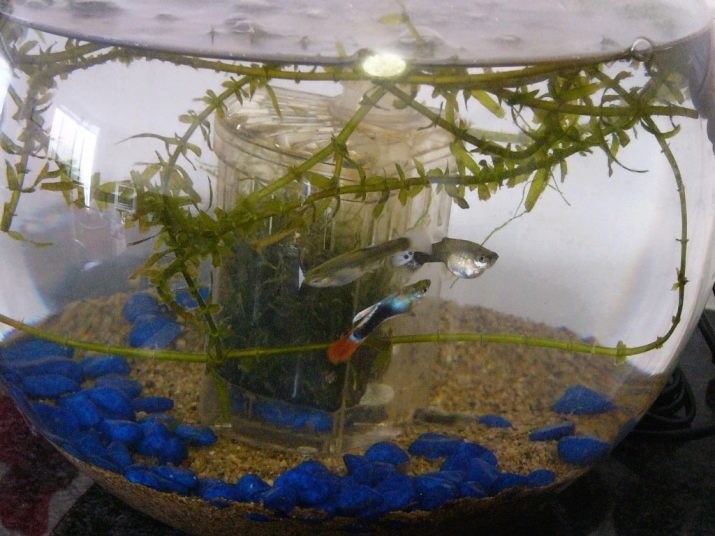
Spawning
If the male is actively circling around the female - this is the first sign that spawning has begun. A couple rushes around the aquarium, and at this moment an important process takes place: the male, with the help of gonopodia, fertilizes the eggs in the female’s stomach. Once the "mating dance" is completed, the fish can be seated in the aquariums in which they were originally kept. The female should not be left alone in spawning, the pregnancy of the guppy is quite long - almost a month, and the fish can get bored alone.
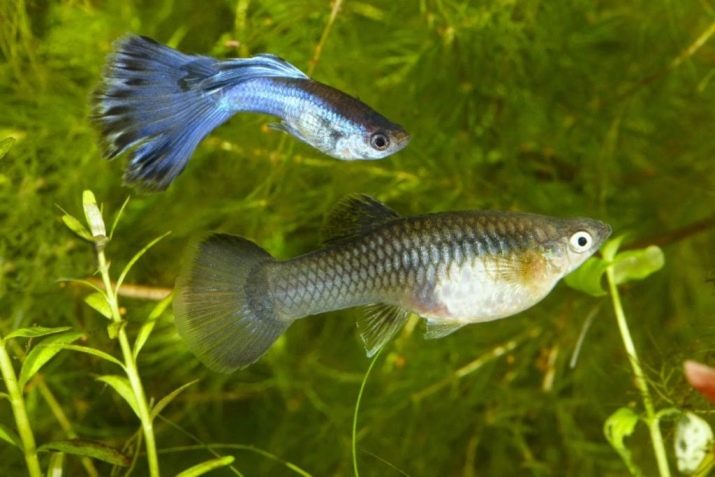
Childbirth
After 22 days after fertilization, the female is closely monitored. With the approaching birth, her behavior changes:
- the fish refuses food;
- becomes agitated;
- hiding in thickets and other shelters.
This behavior suggests that babies should appear during the day, so the female is placed in a separate container. The bottom of the depositor is previously covered with Javanese moss or small-leaved floating plants are placed. This is necessary in order for the fry to have shelter: guppies often have cases of cannibalism. The water temperature should not be lower than in a general aquarium.
At one time, an individual can give birth to from 15 to 100 fry. Fertility depends on age: the older the individual, the more offspring it can bring. Childbirth lasts about 40 minutes. At their end, the female is planted: hungry and tired, she can eat young.

Baby Care
As soon as the kids appeared, they immediately begin to swim in search of shelters. In the early days, children are fed live dust. Using a pipette, a solution with microscopic organisms is dripped directly into the aquarium. This food is ideal for the newly emerged fry, it perfectly stimulates the growth of fish and does not clog the aquarium. Further include in the diet and other feed:
- dry specialized flakes for fry;
- artemia nauplii;
- cyclops;
- daphnia.
In the first week they give food 6 times a day in microscopic portions, then increase the feeding up to 3 times a day. In addition, the kids are provided with good aeration and lighting, for 7 days the lamp does not turn off almost around the clock. Water temperature should be in the range of + 26-30 ° С. Such conditions contribute to the rapid growth of young animals, and after 2 weeks they can be placed in a common aquarium.

See a video below for tips on keeping and breeding guppies.
